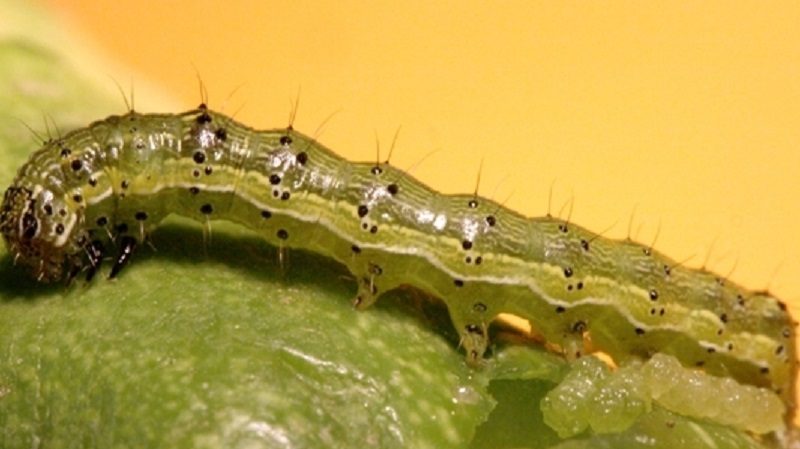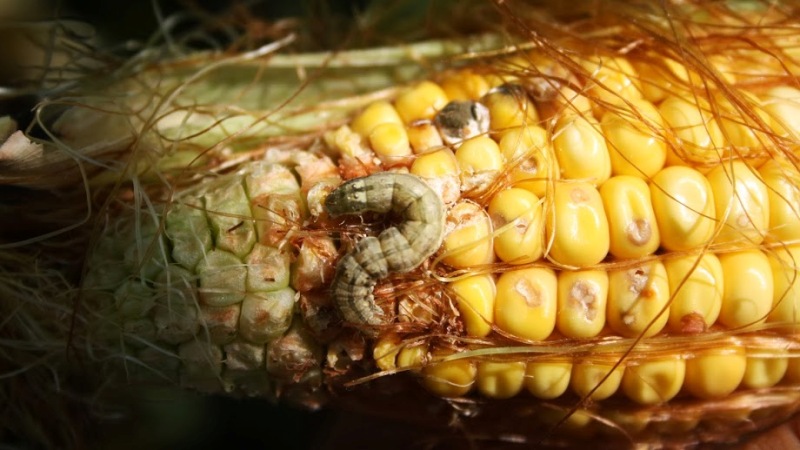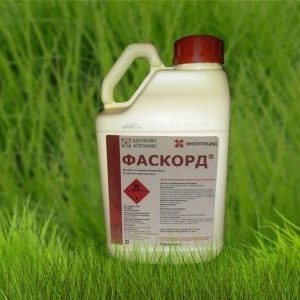What is the danger of a cotton scoop on corn: we detect the enemy, then quickly and effectively fight him
Corn is an important grain and forage crop. Protecting the crop from pests is one of the main tasks of the farmer. Among the main enemies of corn is the cotton bollworm. Infection of crops with these insects leads to a loss of yield up to 20%.
Photos and descriptions of cotton scoops at all stages of development, as well as information on how to deal with insect infestations - in our article.
The content of the article
What is a cotton scoop
The cotton scoop (Latin Helicoverpa armigera) is a butterfly of the scoop family.
The emergence of overwintered adults begins at + 18 ... +20 ºС. The summer dates of the next generations of butterflies overlap, so the cotton moth can be seen until October-November.
It is active at dusk and at night, it feeds on nectar.
The damage is caused by the caterpillars of the winged insect, which eat up crops. Cotton, corn, tomatoes, soybeans, peas and others are under attack. In the southern regions of Russia, the cotton bollworm has become the second most important pest of corn.
The distribution area includes the south of Europe, the Caucasus, Central Asia, tropical and subtropical regions of the world.
How it looks and develops
The size of adult sexually mature individuals (imago) ranges from 10 to 20 mm. Wingspan 30-40 mm. The forewings are grayish-yellow with shades of red, pink, greenish, with two indistinct dark gray spots. Hind wings paler, with brown stripe along outer margin and curved spot in middle. In females, the color of the wings is darker than in males.
The adult scoop lives for 20-40 days. During this time, females have time to lay from 500 to 1000 eggs.
Eggs, reaching 0.5-0.6 mm in diameter, have a characteristic rounded ribbed shape. The color changes from white to green as it develops. They are deposited one at a time, less often 2-3 on leaves, lowered parts of the stem, threads of cobs, panicles.
The duration of embryo growth is from two to four days in summer, in spring and autumn - up to 12 days.
The larvae (caterpillars) are light green, yellow or reddish brown and covered with small thorns. There are three wide dark lines along the body. A yellow stripe runs under the spiracle on the side.

The larvae develop in 13-22 days and go through 6 growth stages. On the last of them, the caterpillars reach a length of 35-40 mm.
Larvae pupate in the soil at a depth of 4-10 cm or on the cob of corn. Pupa is red-brown, 15-22 mm long, with two parallel processes located at the narrowed end. It develops within 10-15 days.
Interesting fact. The adults emerge from the pupae and the cycle repeats. In the climatic conditions of the Krasnodar Territory, the insect develops in three generations, in the Stavropol Territory, in two.
Symptoms of defeat
The plants on which the cotton bollworm has settled are clearly visible against the background of healthy ones:
- rounded holes are noticeable on the upper leaves, since the caterpillars feed on soft greens before the panicles appear;
- pistil filaments are eaten or completely destroyed;
- larvae penetrate the cobs and gnaw the grains;
- insect excrement is visible on the cob.
Harm done
The larvae (caterpillars) of the cotton bollworm inflict direct harm by eating the pouring corn grains.
The destruction of pistil filaments leads to inadequate pollination and the formation of poorly grained ears.
Contamination of the ears with insect waste products, damage to plant tissues contribute to the infection of corn with fungal infections: fusarium and bladder smut.
Infection of crops with cotton bollworm reduces the quantity and quality of products. In case of mass spread of the pest, the death of plants is possible.

Control methods
The decision on the need for treatment is made based on the economic threshold of harmfulness (EPV) of the parasite. To establish it, pheromone traps are used. On fields with an area of up to 5 hectares, 3 traps are set, over 10 hectares - additionally, one for every 5 hectares.
Catching 20 butterflies in three days indicates a population density within the EPV-5 larvae per 100 plants. The capture of more than 25 individuals signals the excess of the permissible level and the need to combat the pest.
reference... The economic threshold of harmfulness is the minimum number of pests at which the costs of control will be paid off by income from the saved crop.
To combat the cotton bollworm in corn, chemical agents, biological methods, folk recipes and agronomic techniques are used.
Chemicals
Insecticide treatments are recommended during the panicle period.
In the phase of mass summer of butterflies, fields are treated with chitin synthesis inhibitors - preparations based on lufenuron. This class of pesticides includes the drug "Match".
To combat caterpillars, enteric drugs are used. These tools include:
- «Fascord- concentrate of α-cypermethrin emulsion. A 0.05% working solution is prepared from the concentrate. Working fluid consumption 200-400 l / ha. During the growing season, no more than two treatments are carried out. The waiting period before harvest is at least 28 days.

- "Decis Profi- water-dispersible granules based on deltamethrin. Spraying is carried out during the growing season with a working fluid flow rate of 200-400 l / ha (0.05-0.07 kg on dry matter). The death of pests occurs within an hour after treatment. The drug is used 49 days before harvesting and no more than twice a season.
- "Karate Zeon"- a preparation based on λ-cyhalothrin, produced in the form of a microencapsulated suspension. The consumption of the drug is 0.2-0.3 l / ha. Consumption of working solution 200-400 l / ha for ground spraying, 25-30 l / ha for aviation.
- «Arrivo"- an emulsion containing cypermethrin as an active ingredient. The flow rate of the working fluid is 200-400 l / ha or 0.32 l / ha of concentrate. Processing is carried out no later than 20 days before harvest.
Insecticide treatments are most effective in the early stages of caterpillar development, before they reach a length of 1.5 cm. At this age, the pests are still unstable to the effects of poisons and did not have time to penetrate the ears.
In the summer period, generations of the cotton bollworm overlap each other, so that the pest can be found in the population at all stages of development. Fortunately, most of the drugs are broad-spectrum and effective against insects in all life cycles, from larva to imago.
Important! When spraying with insecticides, the sides of crops are captured by 20-30 m.
Biological
Biological means of control are based on the purposeful colonization of fields with natural enemies of the cotton bollworm and pathogens of pests.
Trichogramma
The appearance of the first butterflies in traps indicates the beginning of egg laying, which lasts up to 22 days within one generation. During this period, trichogramma (an insect from the genus of moths) begins to settle on corn plants. Trichogramma larvae parasitize the eggs of the cotton bollworm.
Trichogramma in the phase of an adult insect is released for crops three times: at the beginning of laying eggs with a scoop, then after 5-6 days. Each time, 60-80 thousand insects are populated per hectare. Trichogramma is released in the morning or evening hours at least at 50 points per hectare for uniform distribution. In this case, the sides of the fields are also saturated.
The use of Trichogramma on corn crops reduces crop losses from pests by 20%.
Gabrobragon
The gabrobragon is effective against caterpillars. Females of the entomophage lay up to 50 of their eggs in the body of the moth larva. Both openly living and caterpillars that have penetrated into the cob are infected. The victim remains alive, but loses mobility and the ability to feed.
The release rate is 600-2000 individuals per hectare twice a summer.
reference... The greatest effect is brought by complementary releases of trichogramma (against eggs) and gabrobragon (against caterpillars).
"Bitoxibacillin"
"Bitoksibacillin" contains bacteria Baccilius thuringiensis, as well as their metabolites: beta-exotoxin and delta-endotoxin. After processing, the preparation with leaves will enter the intestines of the pests. The caterpillar loses its ability to feed and dies within 3-5 days. Spraying is carried out against each generation of the cotton bollworm with an interval of 7-8 days.
The consumption rate is 2-4 kg per hectare, the consumption of the working fluid is 200-400 l / ha. The solution is prepared in such an amount that it can be used within three hours. Treatments should be carried out at a temperature not lower than +8 ºС in dry, calm weather.
Folk recipes
Folk methods are used in private households. Such funds are effective for minor pest infestations.
The most popular are the following recipes:
- Wormwood decoction. Pour 1 kg of herb with three liters of water and boil for 15 minutes. Spray the plants twice with an interval of 7 days.
- Tomato broth... 3-4 kg of tomato tops are poured with 10 liters of water and boiled for 30 minutes, then filtered. To prepare the working fluid, take one part of the broth for 3 parts of water. Plants are sprayed at a rate of 5 liters per 10 m2.
- Hot pepper decoction... Take 0.5 kg of dry or 1 kg of fresh red hot pepper, add 10 liters of water, boil for an hour, insist for a day. For spraying, the broth is diluted with water in a ratio of 1: 8.
- Infusion of garlic. Grind 2 cloves and leave in 1 liter of water for 3-4 days. For processing corn, the infusion is diluted with water 1: 5.
- Kerosene and soap mixture. 400 g of grated laundry soap is ground and dissolved in 1 liter of boiling water. 9 L of water and 800 ml of kerosene are added to the solution. The resulting composition is used immediately.
Agrotechnical techniques
The complex of agrotechnical measures to combat the cotton bollworm includes:
- Reduction of breeding foci of the pest. Since the butterfly is able to reproduce and feed on weeds (swan, cable car, ragweed) in autumn, it is important to enlarge field maps, plowing and development of adjacent vacant lands.
- Extermination of wintering pests - removal of overgrowth, destruction of plant residues, digging of the sides of fields, deep plowing with a seam turn to a depth of 30 cm, and in fields heavily weed with perennials - by 35 cm.
- Cultivation of row spacings, which is especially important during the pupation period of the pest.
- Destruction of weeds.
Preventive measures
To preserve the harvest, hybrids are planted and varietiesless susceptible to pest attacks.
It is worth paying attention to:
- simple hybrid Yarovets 243 MV (silage direction);
- three-line hybrid Yubileiny 390 MV (grain direction);
- grain hybrid Ladoga 250 MB.
Sowing at the optimal time will avoid large losses of grain corn. The plants will have time to gain strength and bloom before the mass summer and the reproduction of the cotton bollworm.
Advice from experienced farmers and gardeners
Several recommendations from experienced vegetable growers:
- Place small plastic jars on the site as bait traps. Fill them with fermenting liquids (kvass, compote, molasses). Periodically clean the traps of insects and change the bait.
- Plant odorous herbs around the corn rows that repel insects: basil, cilantro, marigolds.
- To attract pest-eating birds, hang feeders around the area.
Reviews
Many farmers and gardeners want to abandon the treatment of crops with chemicals, but doubt the effectiveness of biological agents. A couple of biologics reviews will help you make a decision.
Peter, Rostov-on-Don: “I plant corn every year. This year, on the advice of neighbors, I tried to process the plantings from the scoop with "Bitoxibacillin". I diluted one teaspoon of the product into half a bucket of water. It took 2 liters of solution for a hundred square meters. The butterflies were not affected, but the caterpillars disappeared after three days. Among the shortcomings is a very unpleasant smell. "
Vyacheslav, Krasnodar Territory: “Trichogramma mostly copes with the scoop, but one release is not enough. Then we repeat the event. "
Read also:
How to get rid of scoops on tomatoes once and for all?
Conclusion
The larvae of the cotton bollworm feed on plant tissues and cause serious damage to corn crops. Damaged ears and stems are often affected by fusarium and other fungal infections. All this leads to partial or complete loss of yield.
To combat the pest, insecticides, biological products, and proper agricultural technology are used. Folk recipes are applicable only in personal gardens, due to their laboriousness and low efficiency. Prevention measures include the planting of hybrids that are resistant to damage by pests.
Control of the population size will help to timely track the excess of the harmfulness threshold and take effective measures to destroy the pest.